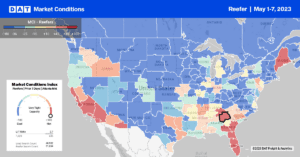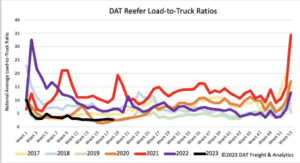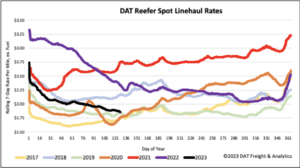If you think of tulips, you’d most likely think of the Netherlands and the patchwork quilt of colored tulips this time of the year. The Netherlands now leads the global tulip trade centered around the world’s largest flower auction in Alsmeer, a stone’s throw from Amsterdam’s Schipol Airport. Such is the Dutch global dominance of this much sought-after flower most growers here in the U.S. get little attention.
The Skagit Valley tulip festival in Washington State would like to change that. Most tulips need at least 12-14 weeks of “cold period” to develop a beautiful flower in the Spring, making the Pacific Northwest an ideal location and on almost the same latitude as the Netherlands. Washington is the United State’s largest producer of tulips, centered around Mount Vernon, approximately 90 minutes north of Seattle. The annual Skagit Valley Tulip Festival occurs each April, with over one million visitors flocking to the region to take in the breathtaking colors. One of the festival’s highlights is “Tulip Town,” known locally as the jewel of Skagit Valley since 1984, founded by Dutch immigrants Anthony (Tom) DeGoede, who immigrated from Holland to Canada in 1956 before moving to Mount Vernon in 1957 to join his brothers Henry and John.
Tulip festivals also extend further north of Mount Vernon into British Columbia, Canada, where numerous tulip festivals are also happening. Canada produces around 61% of tulips imported into the U.S., with 40% crossing the northern border in Buffalo, NY, 29% in Detroit, and 27% in Port Huron, MI — the Netherlands account for the remainder (39%) of tulip imports.
Market Watch
All rates cited below exclude fuel surcharges unless otherwise noted.
Following the devastating impact of Hurricane Ian in Florida late last year and heavy rains in California earlier this year, produce-growing regions in both states appear to have recovered. Looking across the five main produce regions, including California, Florida, and imports from Mexico last week, just 689 fewer truckloads were reported compared to the previous year. The prior week that gap was close to 5,000 fewer truckloads of produce.
Outbound reefer linehaul rates in Florida are heating up following last week’s $0.20/mile jump ahead of Mother’s Day this coming Sunday. At $2.20/mile, reefer rates have increased by $0.76/mile in the last five weeks and are now almost identical to the 2018 and 2022 seasons. Last week’s Florida produce volumes were up 12% YTD, led by solid shipment volumes of watermelons.
In Miami, where 90% of this Sunday’s Mother’s Day flowers land and the largest reefer spot market in the nation, volumes increased by 10% last week – rates were up $0.12/mile to $2.04/mile. Reefer rates from Miami to Hunts Point, NY, surged to $2.65/mile, which is around $0.40/mile lower than the previous year. According to Ratecast, reefer linehaul rates are forecast to peak at $2.90/mile sometime later this month, which would be just $0.18/mile lower than the previous year. In Lakeland, rates jumped by $0.23/mile to $2.01/mile and averaged $2.60/mile for loads to Hunts Point.
In California, outbound reefer rates increased by $0.05/mile to $2.09/mile but still $0.05/mile lower than in 2019. In the large Fresno produce market, rates increased by $0.08/mile to $1.80/mile on a 17% higher volume.

Load to Truck Ratio (LTR)
After being down in the 12-14% y/y range for the last few weeks, national produce volumes were flat last week, according to the USDA. There are definite signs that the produce season is emerging as crucial growing regions start to ship meaningful volumes. For the first time this year, a slight shortage of reefer trucks was reported in all six growing regions in California. After reporting a shortage of produce trucks in Florida the prior week, capacity eased slightly last week. Reefer spot market volumes were flat last week, remaining around 7% higher than in 2019, when produce volumes were just 4% lower. Equipment posts were 4% higher last week, resulting in the reefer load-to-truck (LTR) decreasing from 2.93 to 2.81.

Spot Rates
After being flat in the prior two weeks, reefer linehaul rates increased by a penny-per-mile last week as produce seasonality starts to emerge. At $1.91/mile, reefer spot rates are just $0.02/mile higher than in 2019. Compared to the same time the previous year, spot rates are $0.48/mile lower and identical to the average in pre-pandemic years for Week 18.



